In most pumping systems, the mechanical seal is a small component doing an outsized job keeping fluids contained, preventing leakage, and maintaining system efficiency. Yet, when the wrong seal type is chosen, or when it’s poorly maintained, the consequences can be expensive: unplanned downtime, product contamination, energy loss, and even equipment failure.
With so many types of mechanical seals for pumps available, each with its own design, materials, and application strengths, knowing which one to use isn’t just a technical decision. It’s a reliability decision that directly impacts operational costs, maintenance schedules, and environmental compliance.
This guide breaks down the main types of pump mechanical seals, where they fit best, and how to match them to your pumping conditions. Along the way, we’ll address common selection mistakes, share field-proven practices, and show how industry leaders like Chemitek integrate these solutions into durable, high-performance pump systems.
Key Takeaways
Seal choice impacts long-term performance: The type of mechanical seal you select influences pump efficiency, operational stability, and overall lifecycle cost, not just initial fit.
Materials and environment must align: Seal reliability improves when face materials, elastomers, and environmental controls are carefully matched to the fluid properties and operating conditions.
Advanced designs meet specialized demands: From slurry-ready heavy-duty seals to high-speed gas-lubricated or cryogenic models, specialized engineering tackles challenges that standard seals can’t withstand.
Prevention is better than replacement: Most premature seal failures result from system or installation issues rather than manufacturing faults. Addressing root causes early can significantly extend service life.
Chemitek delivers engineered reliability: By combining material science, custom support systems, pre-installation engineering advice, and ongoing performance monitoring, Chemitek transforms seals from consumables into long-term assets.
Understanding Pump Mechanical Seal Basics
A mechanical seal is the interface between the rotating pump shaft and the stationary pump casing, designed to prevent the pumped fluid from leaking into the atmosphere.
Unlike traditional packing, which relies on a controlled leakage for lubrication, mechanical seals create a precise, engineered seal between two extremely flat surfaces: a rotating seal face attached to the shaft and a stationary face fixed to the casing.
The success of this seal depends on three key factors:
1. Seal Face Materials:
Common combinations include carbon vs. ceramic or silicon carbide vs. tungsten carbide. The pairing is chosen based on fluid abrasiveness, temperature, and chemical compatibility.
Seal Face Material Compatibility Guide
2. Secondary Seals:
These components, commonly O-rings, gaskets, or flexible bellows, sit between the rotating and stationary parts of the seal assembly to ensure no leakage occurs around the seal faces.
A good secondary seal does more than just “stop leaks”:
- Compensates for misalignment by flexing slightly to keep the seal faces in correct contact.
- Handles thermal expansion and contraction without losing integrity, especially in pumps operating under variable temperatures.
- Resists chemical attack from the pumped fluid, which is why elastomer selection (like Viton, EPDM, or PTFE) must match the chemical profile of the service.
Poorly chosen secondary seals can harden, crack, or swell, leading to premature seal failure even when the faces are in good condition.
3. Environmental Controls:
Mechanical seals often need controlled conditions to perform reliably over time, especially in abrasive, high-temperature, or high-pressure environments. Common methods include:
- Flush Plans (API Plan 11, 21, 32, etc.): Introduce clean, cool fluid to wash away solids, reduce temperature, and stabilize pressure around the seal faces.
- Cooling Jackets: Circulate coolant around the seal housing to dissipate heat generated by friction or hot process fluid.
- Pressurized Barrier Fluids (for double seals): Maintain a positive pressure between two sets of seal faces to keep contaminants out and reduce wear in slurry or hazardous services.
Well-designed environmental controls can extend seal life by a factor of three in demanding environments, making them a proactive reliability strategy rather than a last-minute fix.
With the right seal design and installation, it’s possible to keep a pump running for years with minimal intervention. But mismatched materials or poor setup can trigger rapid wear, heat build-up, and costly leaks long before the next maintenance window.
That’s why it’s worth understanding each pump mechanical seal type and the conditions where it works best before making a choice.
Main Types of Pump Mechanical Seals

Choosing the right mechanical seal type isn’t just about matching dimensions it’s about matching the seal’s working principle to your pump’s operating environment.
While seal face materials and environmental controls matter, the design configuration plays the biggest role in how a seal responds to pressure, temperature, shaft motion, and fluid properties.
Below are the core pump mechanical seal types, how they work, and where they perform best.
1. Single Mechanical Seals

A single seal has one pair of rotating and stationary seal faces. It is the simplest, most cost-effective option and is widely used in clean, non-hazardous services.
Best for:
- Clean water and light hydrocarbons
- Low to moderate pressure
- Non-toxic, non-abrasive fluids
Single mechanical seals are often chosen for their lower initial cost, straightforward installation, and ease of replacement, making them a practical choice for standard pumping applications.
They require minimal auxiliary equipment, which keeps setup simple and reduces overall system complexity.
However, they are less suitable for hazardous, abrasive, or high-pressure fluids, as their design leaves the seal faces directly exposed to the process fluid. This exposure can lead to faster wear and reduced service life in demanding environments.
2. Double Mechanical Seals
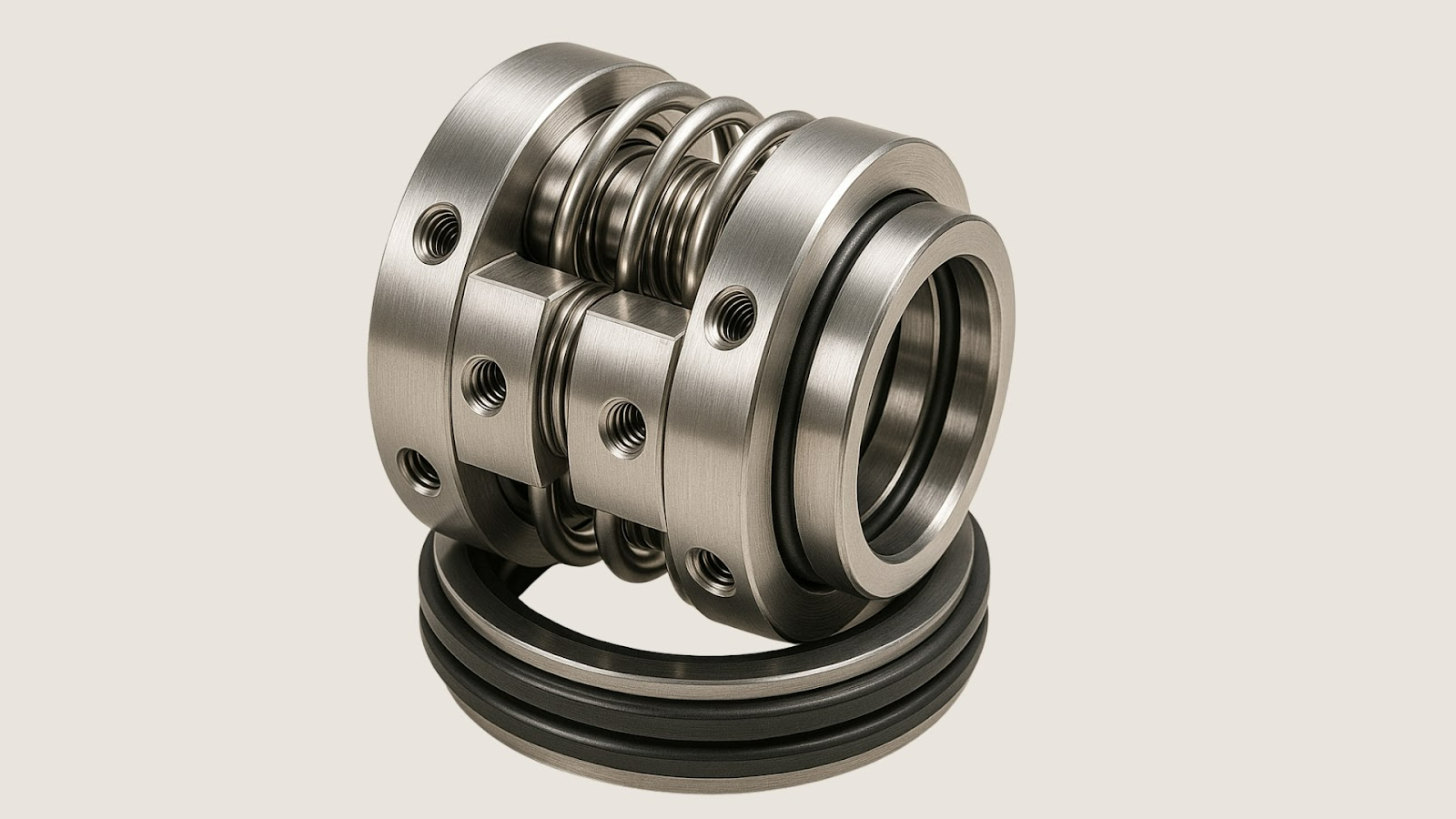
Double seals use two sealing interfaces either back-to-back, face-to-face, or tandem with a buffer or barrier fluid in between.
Best for:
- Hazardous or toxic fluids where zero leakage is required
- Abrasive slurries and high-pressure applications
Double mechanical seals offer enhanced reliability in severe service conditions, as the barrier fluid both lubricates and cools the seal faces, reducing wear and extending lifespan.
The secondary seal also serves as a backup, maintaining containment if the primary seal fails, which makes them a preferred choice for critical or hazardous applications.
The trade-off is that double seals come with higher installation and operating costs. They also require an external barrier or buffer fluid system, which adds complexity and demands ongoing maintenance to ensure consistent performance.
3. Cartridge Seals
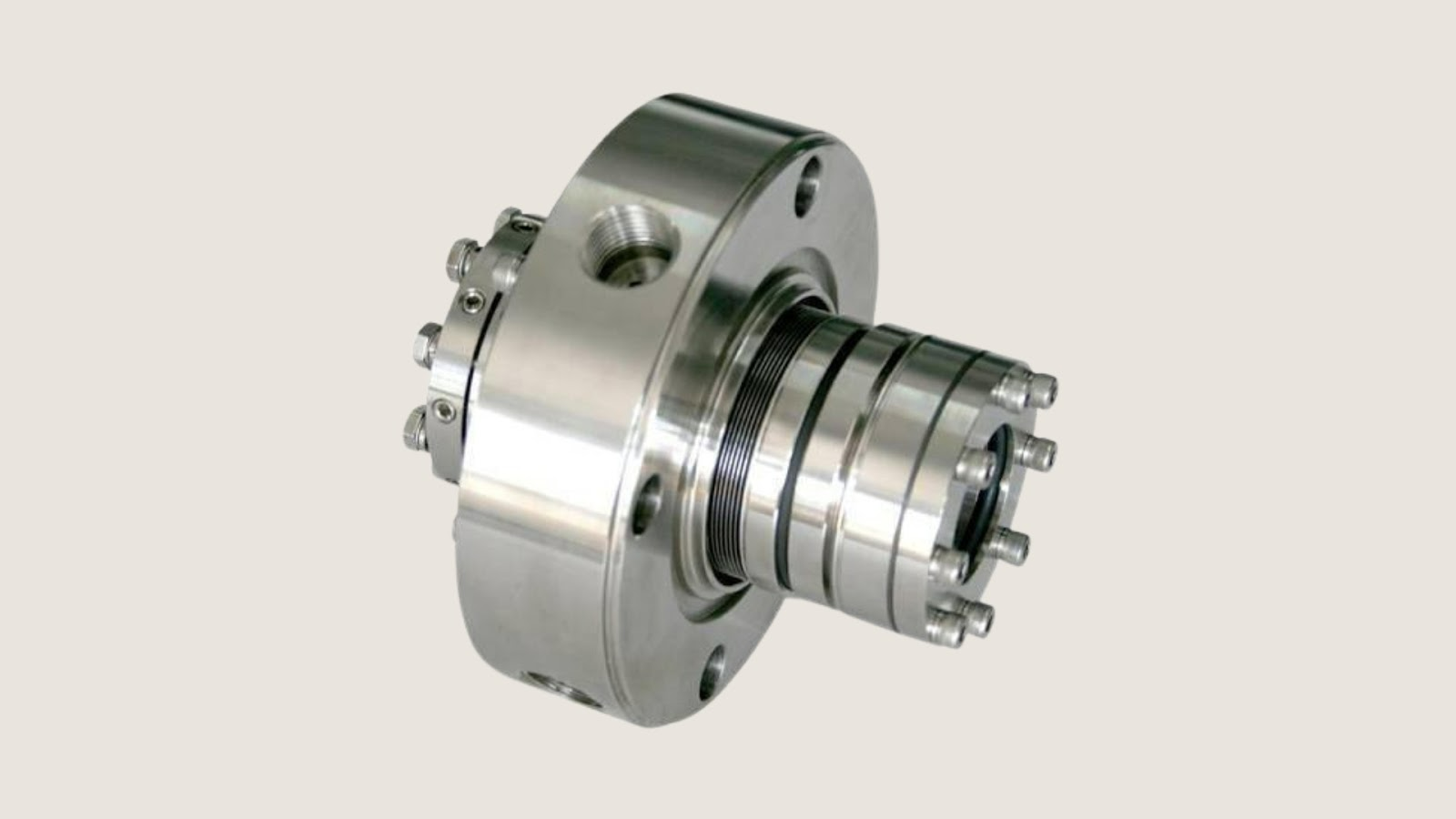
Cartridge seals are pre-assembled units containing all seal components, sleeve, and gland plate in one package.
Best for:
- Reducing installation errors in maintenance-heavy environments
- Standardizing seal replacement in multiple pumps
Cartridge seals allow for drop-in installation with factory pre-set tolerances, which significantly reduces the risk of misalignment or incorrect assembly.
This design also helps shorten downtime during maintenance, as the seal can be replaced quickly without requiring complex setup or adjustments.
The main drawback is that cartridge seals typically have a higher upfront cost compared to component seals. They also offer limited flexibility for custom adjustments, making them less adaptable in highly specialized or unique pump configurations.
4. Split Seals
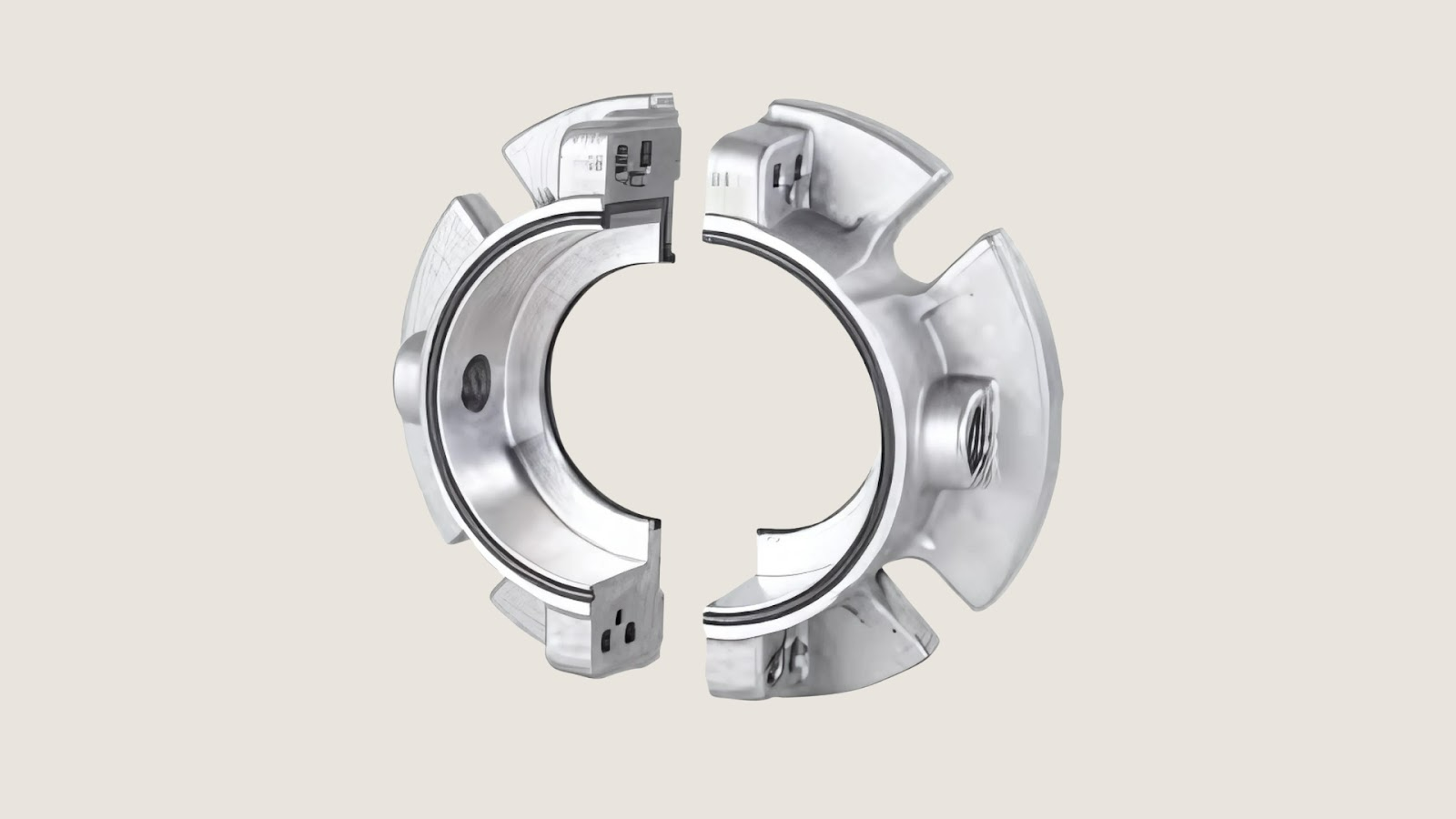
Split seals are designed in two halves, allowing installation without dismantling the pump or moving heavy equipment.
Best for:
- Large pumps with difficult shaft access
- Offshore platforms or remote installations
Split seals can significantly reduce installation time and allow for seal replacement without disturbing the pump alignment or piping. This makes them especially valuable in large or difficult-to-access pump setups.
Their downside is that they tend to be more expensive than conventional seals and can be bulkier, which makes them less suitable for smaller pumps with limited space
5. Balanced vs. Unbalanced Seals
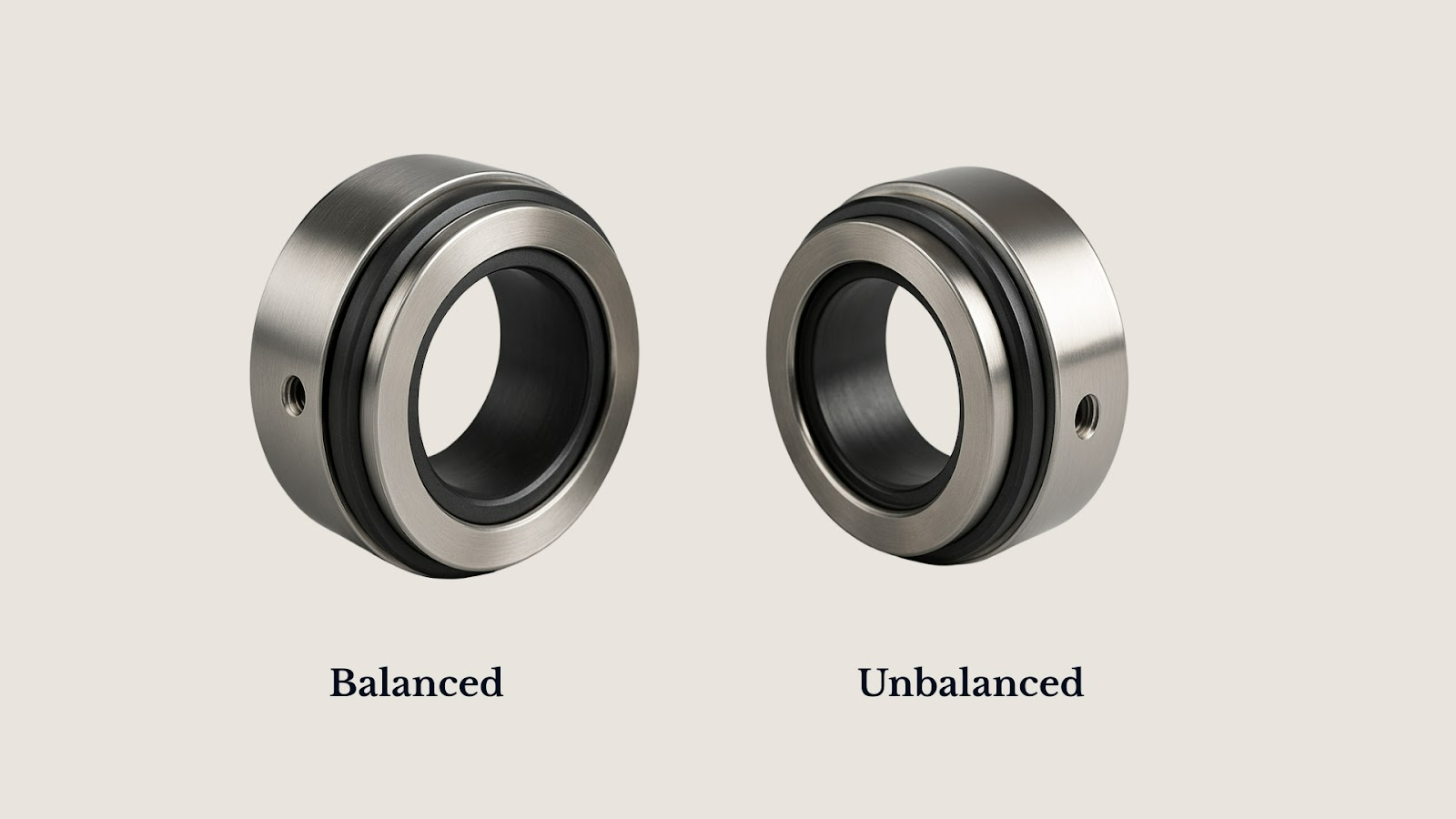
The term refers to the ratio of hydraulic pressure acting to close the seal faces versus the pressure holding them apart. This “balance ratio” determines how much force the seal faces experience under operating pressure.
Balanced Seals:
Work by modifying the geometry of the seal faces and positioning of the secondary seals, balanced designs reduce the hydraulic closing force on the faces.
Best For: High-pressure, high-speed, or high-temperature applications where excessive closing force would cause overheating or face distortion.
Balanced seals can handle 50–100% higher pressures than their unbalanced counterparts, making them ideal for demanding pump applications. They generate less heat during operation, which helps reduce thermal distortion and prolongs seal face life.
These seals also perform more efficiently when pumping fluids with poor lubricity, such as light hydrocarbons.
Their drawbacks include slightly higher complexity and cost compared to unbalanced seals. They also require careful material selection to prevent leakage at low pressures, which can make them less forgiving in certain operating conditions.
Unbalanced Seals:
Have a higher hydraulic closing force because the full process pressure acts on a larger portion of the seal face area.
Best For: Low-pressure, clean fluid applications where seal face lubrication is not an issue.
Unbalanced seals are simpler and more economical to manufacture, making them a cost-effective choice for many low-pressure pumping applications. Their design provides excellent sealing performance at low pressures due to a higher closing force on the seal faces.
However, they are not suited for high-pressure or abrasive services, as the higher closing force generates more heat and accelerates wear. They are also more prone to face damage if operated near dry-running conditions, which can quickly lead to seal failure.
Quick Comparison Table: Mechanical Seal Types
While these primary categories cover the majority of pump applications, certain operating environments push seals to their limits. In such cases, standard designs can’t maintain performance or service life, prompting the need for solutions purpose-built for extreme demands.
Specialized Pump Mechanical Seals for Challenging Conditions

Situations involving extreme thermal swings, aggressive media, rapid shaft speeds, or constant particle impact require designs that can handle these stresses without sacrificing reliability or service life.
1. Bellows Seals
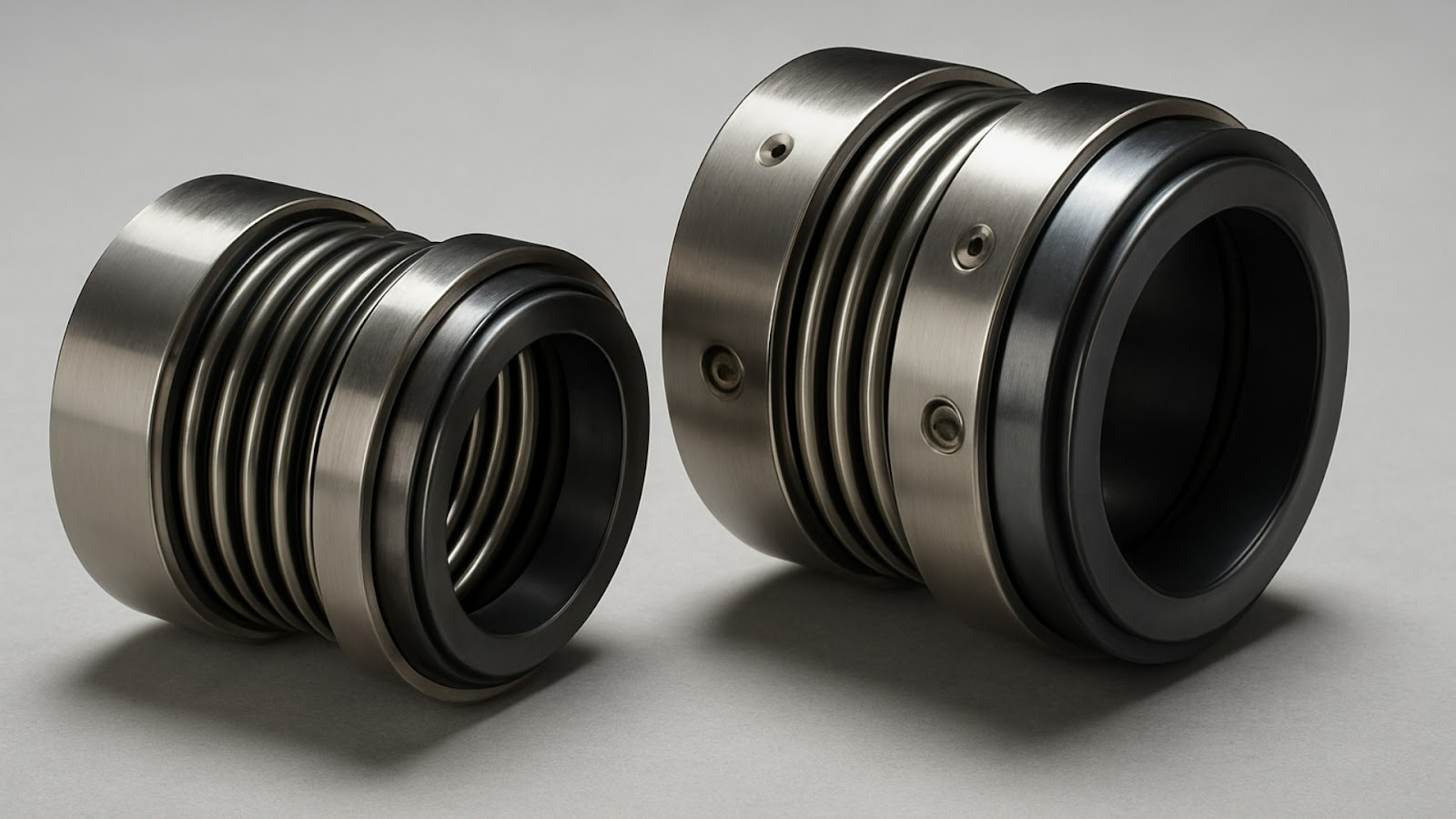
Bellows seals replace the traditional dynamic O-ring with a flexible bellows element, removing the risk of elastomer wear, sticking, or shaft fretting.
- Metal bellows: Ideal for high-temperature applications, such as steam service and refinery pumps, where temperatures exceed elastomer limits.
- Elastomer bellows: Designed for chemical resistance in corrosive media, paired with chemically compatible face materials.
Best suited for: Chemical processing, fertilizers, and refinery service where thermal cycling or chemical attack is common.
It offers excellent resistance to high temperatures and corrosive media without shaft wear, but can be costlier and less tolerant to misalignment than O-ring designs.
2. Dry Gas Seals
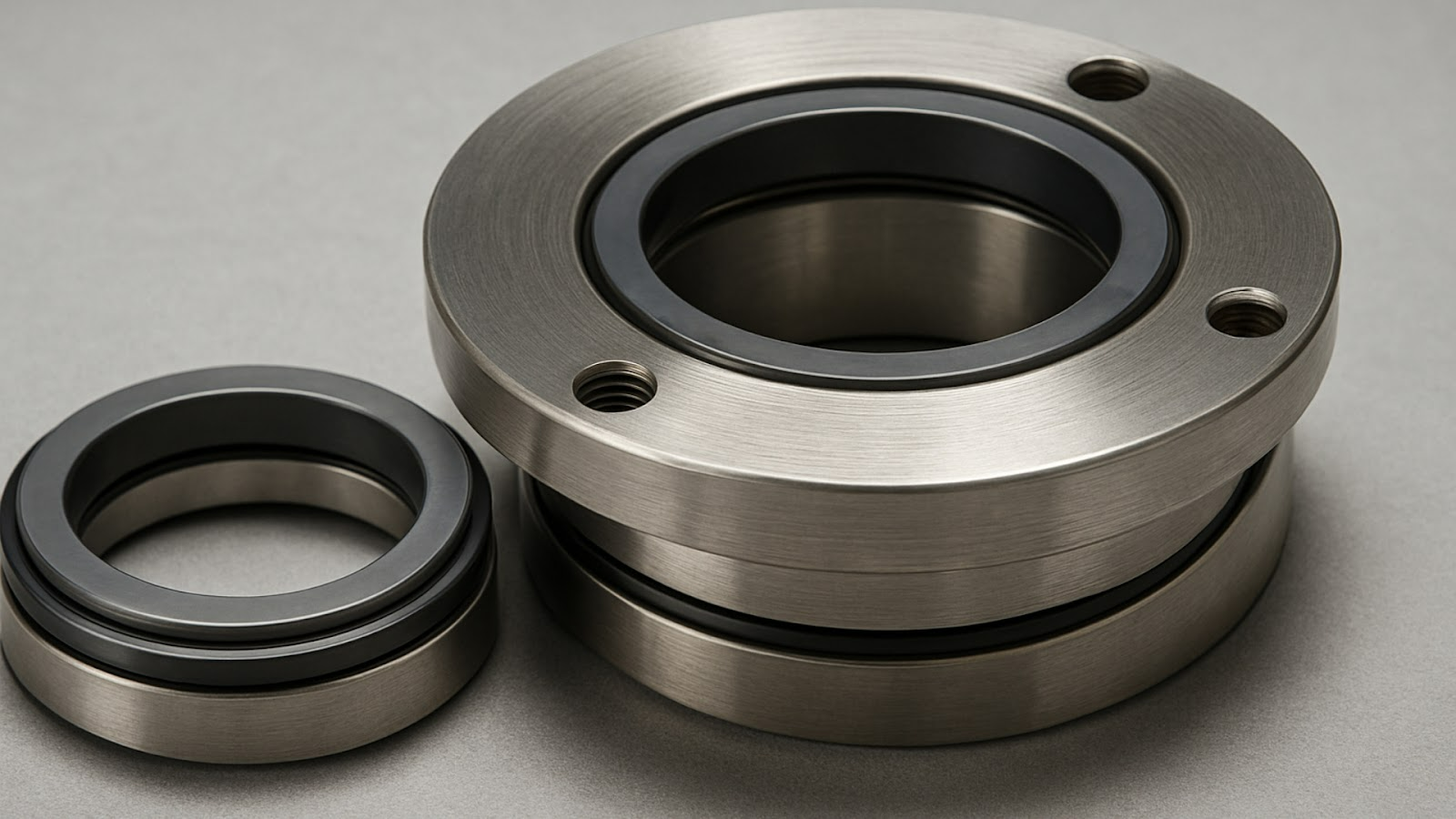
Used extensively in compressors, dry gas seals operate with a thin, controlled gas film between the seal faces, virtually eliminating wear and reducing leakage to negligible levels.
They excel in applications where fluid contamination must be avoided and equipment runs at high speeds.
Best suited for: Petrochemical, natural gas transmission, and pipeline compressor stations.
They deliver near-zero leakage and minimal wear in high-speed applications, but require precise gas supply control and are not suited for dirty or particle-laden fluids.
3. Slurry-Duty Seals

Slurry seals are designed with hardened materials such as tungsten carbide or silicon carbide and feature flush ports or cyclone separators to remove solids from the seal faces.
Best suited for: Mining, mineral processing, pulp & paper, and wastewater treatment.
They provide superior abrasion resistance and extended life in solids-laden fluids, but add complexity and cost due to specialized materials and flush systems.
4. Gas-Lubricated Liquid Seals
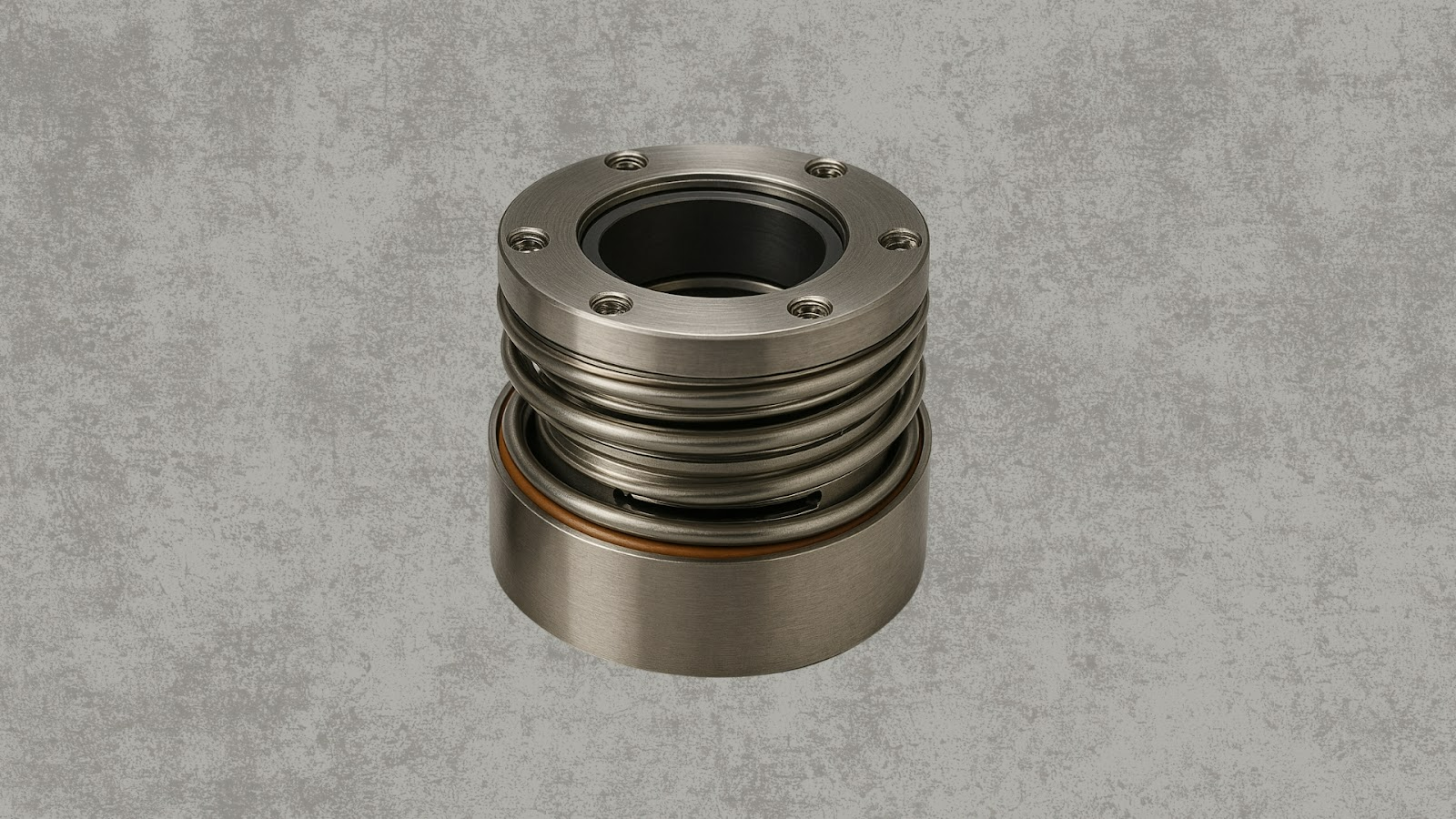
A hybrid between dry gas and liquid seals, these designs inject a small gas flow to improve lubrication and reduce heat, ideal for high-speed or heat-sensitive applications.
Best suited for: Specialty chemical and high-speed pump services.
They reduce friction and heat in high-speed service while improving lubrication, but need careful gas flow regulation and may not be ideal for all fluid chemistries.
5. Cryogenic and Low-Temperature Seals
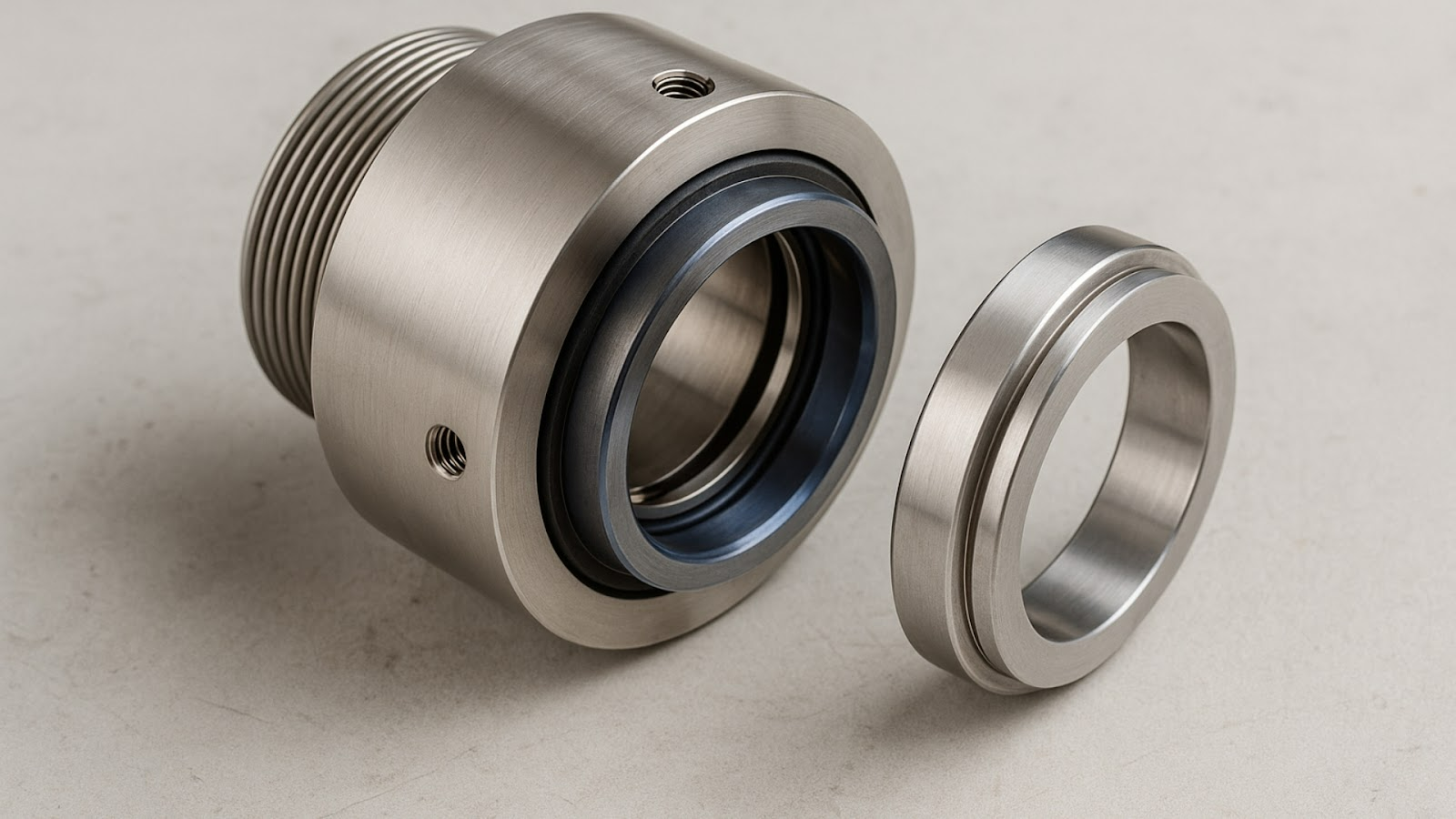
Designed with low-temperature elastomers and isolated spring mechanisms to prevent icing and maintain flexibility in extremely cold service.
Best suited for: LNG transfer, liquid nitrogen pumps, and refrigerated chemical processes.
They maintain flexibility and sealing integrity in extreme cold, but require specialized materials and careful handling during installation.
6. Segmented Carbon Ring Seals
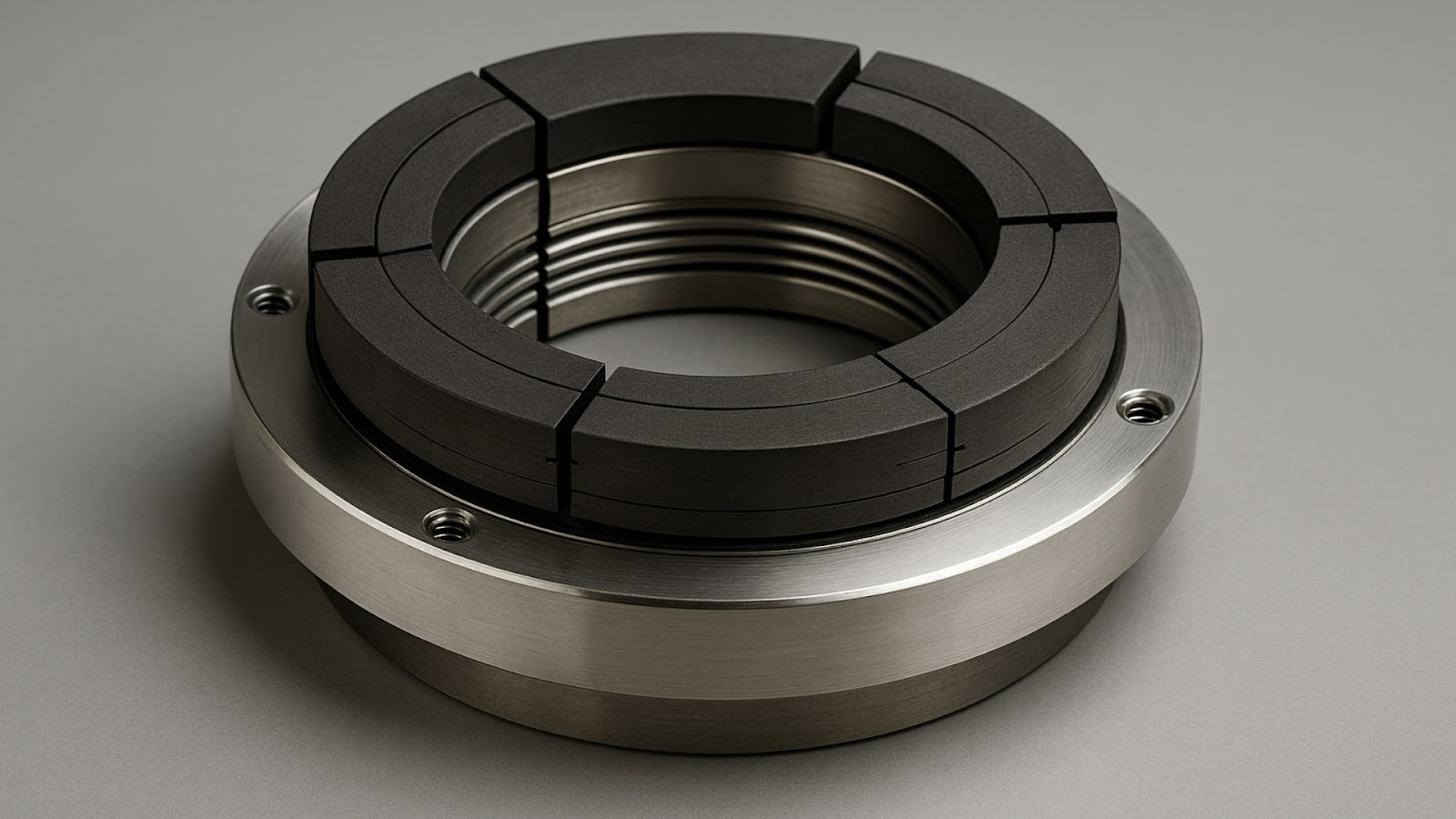
Primarily used in turbines and certain pump applications, segmented carbon rings create a close-clearance seal with low friction, handling both high-speed and moderate-pressure duties.
Best suited for: Steam turbines, blowers, and older high-speed rotating equipment.
They offer low friction and suitability for high-speed shafts, but have limited sealing capability under high pressures and can wear faster in dirty service.
While each specialized seal addresses unique challenges from extreme temperatures to abrasive slurries, the right choice ultimately depends on how well the seal’s capabilities align with your pump’s operating conditions. This is where a systematic selection approach becomes essential.
How to Select the Right Pump Mechanical Seal for Your Application
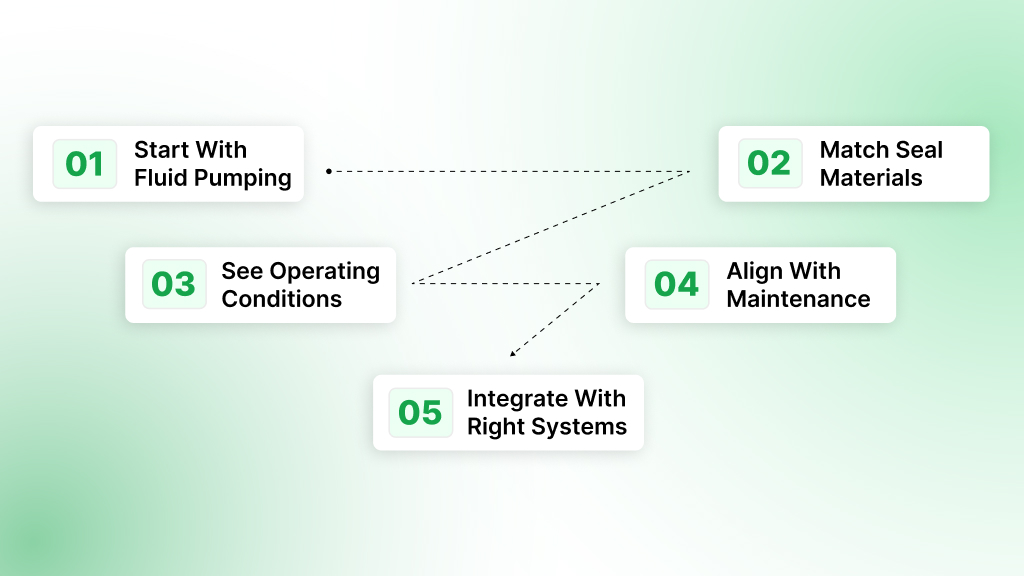
Selecting the right mechanical seal is more than a specification exercise; it’s a decision that affects reliability, uptime, maintenance costs, and even safety. The goal is to align the seal’s capabilities with the demands of your process so it can operate efficiently and last as long as possible.
Here’s a structured approach that blends engineering considerations with practical field experience.
1. Start With the Fluid You’re Pumping
Every decision starts with the process fluid.
- Clean, lubricating liquids can use simpler single or unbalanced seals.
- Abrasive slurries often require double slurry-duty seals with hardened faces and a clean flush (e.g., API Plan 32 or cyclone separator).
- Corrosive chemicals benefit from bellows seals with chemically resistant faces like silicon carbide and PTFE or Viton elastomers.
- Hazardous or volatile fluids may require dual containment seals to protect both the process and the environment.
The fluid’s solids content, chemical compatibility, and lubricity will largely determine seal type, face material, and elastomer choice.
2. Match Seal Materials to the Environment
The right material pairing extends seal life and reduces premature wear.
- Seal faces: Silicon carbide offers excellent wear resistance for abrasives; tungsten carbide is tougher in impact-prone services; carbon offers low friction in clean fluids.
- Elastomers: EPDM handles hot water well; Viton resists aggressive chemicals; Kalrez is suited for extreme chemical resistance; PTFE is non-reactive but less elastic.
- Metal parts: Stainless steels for general use, Hastelloy or Alloy 20 for aggressive chemicals, and titanium for seawater or chloride-rich applications.
3. Factor in Your Operating Conditions
Pressure, temperature, and shaft speed all directly impact seal choice.
- High pressures often require balanced seal designs to reduce face loading.
- Extreme temperatures may call for metal bellows (for heat) or cryogenic-rated seals (for cold).
- High-speed shafts benefit from gas-lubricated designs to reduce heat buildup.
- Variable speeds or frequent start–stops demand robust spring designs and faces that can handle intermittent lubrication.
4. Align With Your Maintenance Realities
Your maintenance strategy should guide seal complexity.
- Limited access or high downtime costs: Choose split seals or cartridge seals that can be swapped quickly without dismantling the pump.
- Less experienced maintenance teams: Use pre-assembled cartridge seals with preset compression to avoid installation errors.
- Well-trained, well-equipped teams: Can manage double seals, custom API plans, and more intricate support systems.
- Critical equipment: Keep spare cartridges ready to minimize outage duration.
5. Integrate With the Right Support Systems
Seal performance often depends on the environment you create for it.
- Flush plans (API Plan 11, 21, or 32) keep seal faces clean and cool in abrasive or dirty fluids.
- Barrier/buffer systems (API Plan 52, 53A/B/C) isolate hazardous fluids and stabilize operating conditions.
- Cyclone separators or strainers remove solids before they reach the seal faces.
Even with the right seal, material, and support system, reliability isn’t guaranteed. Real-world conditions, installation practices, and process changes can still shorten its lifespan. Spotting early warning signs and understanding their root causes is important to preventing recurring failures.
Common Causes of Mechanical Seal Failure and How to Diagnose Them
Studies show that over 80% of failures come from improper selection, installation errors, or poor operating conditions, not from a defective seal itself.
Here’s what typically goes wrong and how to spot it early:
- Improper Installation: Misaligned seal faces, over-tightened fasteners, or damaged elastomers during assembly can cause immediate leakage.
Diagnostic cue: Leakage starts almost immediately after startup. - Dry Running: Running the pump without adequate fluid at the seal faces leads to instant overheating and scoring.
Diagnostic cue: Seal faces appear burnt, discolored, or cracked. - Incorrect Material Selection: Using carbon faces for abrasive slurry or EPDM elastomers in hydrocarbon service causes rapid wear or swelling.
Diagnostic cue: Material deformation, swelling, or severe pitting. - Poor Environmental Controls: Inadequate flush plans or clogged cooling lines create localized overheating.
Diagnostic cue: Uneven wear patterns, with one side heavily damaged. - Shaft Misalignment or Excessive Vibration: Misalignment puts uneven pressure on seal faces; vibration creates intermittent contact and leakage paths.
Diagnostic cue: Irregularly spaced wear marks.
Seal Reliability Tips for Longer Service Life
Even the most precisely engineered mechanical seal will underperform if the surrounding conditions aren’t right. Reliability depends on three things working in harmony: the correct seal type, materials suited to the process fluid, and a support system that manages heat, contamination, and pressure fluctuations.
Preventive maintenance planned around crew expertise, accessibility, and the cost of downtime keeps minor wear from becoming major failure. The right seal and the right support system should always be specified together, ensuring the environment enables the seal to reach its full service life.
When that balance is achieved, plants move from fighting recurring breakdowns to running with predictable performance. That’s exactly where the right partner makes the difference.
Chemitek: Seal Solutions That Go Beyond Supply
In demanding sectors like mining slurry lines, corrosive chemical plants, and high-capacity water treatment, mechanical seals rarely fail because of design flaws alone; it’s usually because the seal and its operating environment weren’t engineered as a complete system. Chemitek’s expertise is built around preventing that disconnect.
1. Engineered for Harsh Realities
- Abrasive services: Hard-faced materials like tungsten carbide or silicon carbide, enhanced with advanced surface treatments.
- Corrosive environments: Chemically inert alloys and elastomers that maintain integrity over long service intervals.
2. Integrated Support Systems
- Tailored flushing, cooling, and barrier fluid setups matched to seal type and process chemistry.
- Designed to fit the pump’s duty cycle and maintenance realities, preventing the heat, contamination, and pressure spikes that cause early failures.
3. Advisory Before Installation
- Collaboration with plant engineers to assess pressure, temperature, and chemical compatibility.
- Optimized face combinations, elastomers, and metallurgy for stability and maintainability.
4. Lifecycle Partnership
- Installation assistance, alignment checks, and maintenance training.
- Condition-monitoring guidance to catch wear patterns early, reducing downtime.
5. Proven Across Industries
From deep-shaft mining to high-purity chemical feed systems, Chemitek’s seals consistently deliver longer service life, lower operating costs, and fewer compliance risks.
Chemitek’s value isn’t just in delivering a robust seal; it’s in engineering an entire reliability ecosystem around it. By combining materials science, application engineering, and proactive service, they help plants move from reactive seal replacement to predictable, planned maintenance.
The payoff is measured not just in longer seal life, but in higher uptime, lower energy costs, and fewer safety or compliance risks.
Conclusion
Mechanical seals may be small, but their impact on pump reliability is enormous. Selecting the right type, matching materials to the process, and supporting it with the right environmental controls can mean the difference between years of trouble-free operation and frequent, costly failures.
Whether you’re upgrading existing pumps, solving recurring seal issues, or specifying equipment for new projects, the smartest move is to view the seal as part of a complete system, not a standalone component.
That’s exactly the approach Chemitek takes, helping you bridge the gap between theory, product, and long-term performance in the field. Get in touch Today!
Frequently Asked Questions (PAA Style)
1. Which mechanical seal type is best for corrosive fluids?
For highly corrosive media, bellows seals, especially those with chemically resistant elastomers like PTFE or high-grade alloys, are ideal, as they eliminate dynamic O-ring interfaces prone to chemical degradation.
2. What causes mechanical seal failure most often?
More than 80% of mechanical seal failures stem from operational or installation issues not manufacturing defects. Common culprits include poor flush plans, incorrect material selection, misalignment, and inadequate environmental controls.
3. How can I extend the service life of a mechanical seal?
Prolong seal life by combining right-fit materials and seal type with proper support systems such as flush, cooling, or barrier plans plus good installation, condition monitoring, and maintenance strategies tuned to your operating environment.
4. Why should a seal and its support system be specified together?
Even the most robust seal will fail if operating conditions are off. Matching seals with tailored support systems covering flushing, cooling, and pressure control is critical to avoid premature failure and unplanned downtime.
5. What sets Chemitek’s mechanical seal solutions apart?
Chemitek delivers bespoke engineering not just seals, but engineered support systems tailored to every application. This includes materials selection, flush/barrier design, installation support, and proactive lifecycle maintenance, ensuring peak performance in harsh environments.
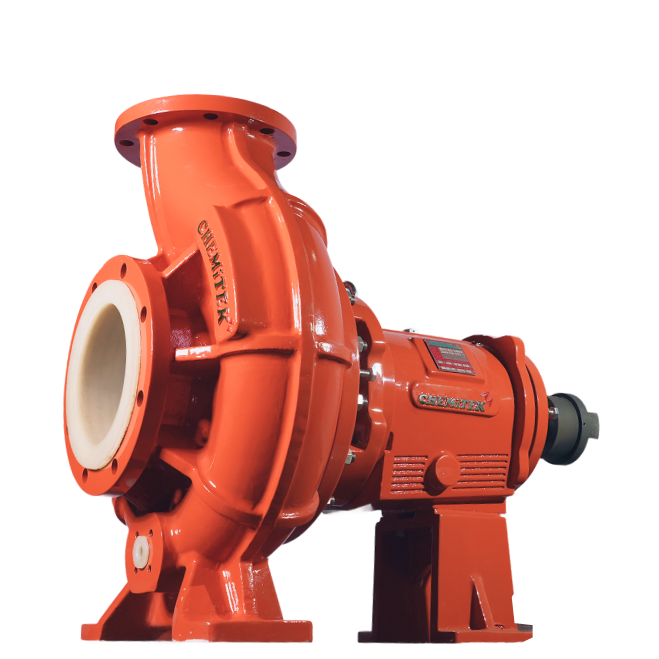
Latest posts
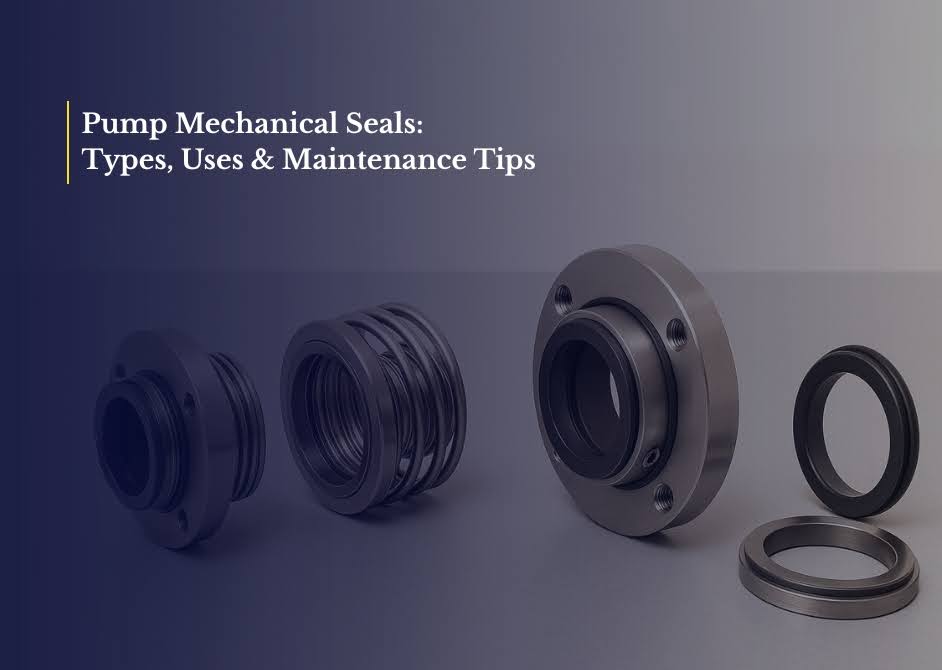
Types of Mechanical Seal for Pumps: A Complete Guide
Ready to Upgrade Your Process Operations?